1inch Exchange Review: Leading DEX Aggregator

1inch is a decentralized exchange (DEX) aggregator that allows users to find the best prices for cryptocurrency trades across multiple DEXs. It sources liquidity from various exchanges and splits a single trade across multiple exchanges to offer the best rates. 1inch offers flexible swaps and trades through its native protocol, which scrapes a handful of decentralized exchanges for the cheapest prices and reroutes customers’ trades between them to try and ensure they get the best prices
With decentralized finance so explosive over the past year, it’s no wonder that there are so many DEXs and liquidity pools operating and popping up.
Keeping track of them all and which are offering the best trading conditions can be an absolute nightmare. And that’s where the 1inch Exchange is so interesting.
The 1inch Exchange calls itself the “Leading DEX Aggregator”, and we’re inclined to agree. It also has liquidity pools, and users can farm the native 1INCH token on the platform. That 1INCH token is also interesting as an instant governance token.
1inch Exchange Pros & Cons
As a short introduction to the strengths and weaknesses of the platform, we include these pros and cons to get started for your consideration:

1inch, like so many other Ethereum-based projects, emerged from an ETH dev conference. This time it was at the ETHGlobal hackathon back in 2019. It was founded by Sergej Kunz, the CEO of 1inch, and Anton Bukov, its CTO.

In August 2020, they completed a Seed round from Binance Labs of about $2.8 million. Then, in early December of 2020, they managed to close a much larger $12 million funding round led by Pantera capital. As of Dec 2, 2021, they managed to raise $175 million led by Amber Group with participation from other known crypto VCs such as Fenbushi Capital, Alameda Research and other blockchain projects such as Celsius and Nexo, as reported by CoinDesk. The project is valued at $2.25 billion, based on a report by Messari commissioned by the 1inch team.
Initially, the founders of 1inch Exchange created a separate portal for yield farming called Mooniswap. It was basically a Uniswap clone. Since December 2020, that portal has been deprecated as the 1inch Liquidity Protocol was launched. Now, 1inch really functions more like Uniswap, with a combination of exchange and liquidity pools. However, the platform likely offers better rates because it pulls liquidity from many other decentralized exchanges.
The following review will go into more detail regarding the features available at the 1inch exchange and explain how to go about making an exchange or providing liquidity to the pools. There’s a lot to cover, so let’s dive in.
What is 1inch Exchange?
The 1inch exchange is a decentralized exchange, or DEX, aggregator. Rather than working as an exchange itself, it splits orders between other DEXs and private liquidity providers to find the best possible exchange rates. In its current state, 1inch supports over 188 liquidity sources from 7 blockchains, 1.6 million users and a volume of more than USD134 million.
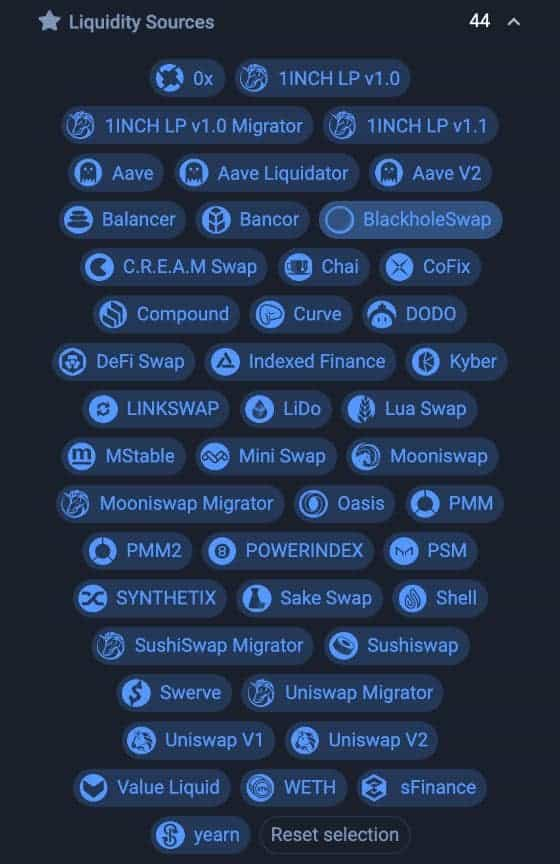
At 1inch Exchange, connecting a web3 wallet and then swapping ERC-20 tokens at the best possible rates is a simple process. The exchange will even split orders between several exchanges if that’s what it takes to get the best rate for an entire order.
It is also possible to create limit orders at 1inch, earn by staking 1INCH tokens, and supply liquidity to the 1inch liquidity pools.
1inch Order Routing
1inch uses a proprietary API they’ve named Pathfinder, which contains a discovery and routing algorithm. Pathfinder finds the best possible paths for any proposed token swap, splitting a swap across several exchanges and even across different market depths of the same exchange if necessary. Furthermore, with the dynamic fill mechanism, amounts in the exchanges with the unfavorable rate gets moved to the ones with favorable rates even when processing the transaction. As a result, the exchange rate and/or gas fees a user receives are better than what they would have gotten on any single exchange.
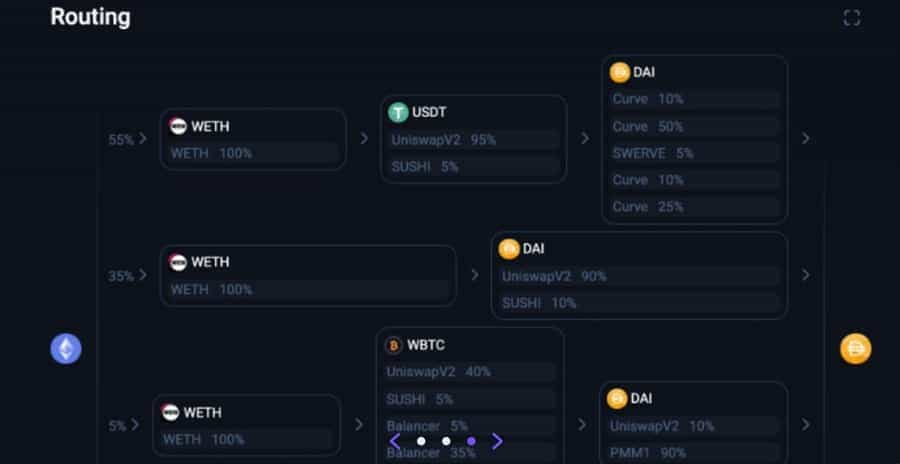
The addition of Pathfinder was the major part of the upgrade to 1inch version 2. Pathfinder uses different' market depths' as bridges between source and destination tokens. Thereby, the algo uses a more sophisticated approach than just splitting a swap across different protocols. In addition, it can split part of the swap for a specific protocol between different' market depths' on the same protocol, getting the user the best rates, also taking into account gas consumption.
1inch Aggregation Protocol v3
A key linchpin in 1inch's offerings is the Aggregation Protocol. It allows for splitting a single transaction into multiple DEXs in search of the best rates. Since its inception, new developments have emerged, giving it more oomph. The most significant improvement in the latest version is the substantial reduction of gas fees. According to Messari, "....Previously, swaps on Uniswap v2 were cheaper than on 1inch, but now the opposite is true. Swapping ETH for DAI on 1inch, for example, requires 10.3% less gas than the same trade on Uniswap and 4.9% less than on 0x."
Another feature offered is utilizing collateral tokens during routing. Like those minted on AAVE and Compound, these tokens need to be packed or unpacked for them to be used in routing orders. This is now done automatically by the protocol for users.
Limit Order Protocol V2
When DeXes first started out, you could only place market orders on it. That means trying to catch the tokens at a good price and swapping them in that instant, or just buying what you can and hoping for the best. The limit order, which is the ability to buy or sell at a price pre-determined by the user, used to sit in the realm of CEXs. 1inch introduced this function by adding these orders to a centralized database managed by the team. The orders are filled like regular spot orders. As the gas costs are covered by the takers of the limit orders in addition to the value of the trade, this becomes a zero-fee order for the user, which will undoubtedly spur more to do the same. This functionality will unlock other functions such as stop-loss orders and trailing stop losses.
Aside from price triggers, users can also specify other non-price conditions, such as to buy/sell after the results of a national election are announced. This widens the scope of what people can take aim at when they set the buy/sell price for an asset.
V2 of the protocol introduces the ability for users with zero ETH balances to swap supported tokens, drastically lowering the barrier for new/first-time users. We can imagine this becoming a popular function pulling in more users to its protocol.
1inch Exchange Fees
One of the positives of using 1inch is its complete lack of fees. There are no exchange fees, no deposit fees, and no withdrawal fees. The only costs for users are only dependent on the decentralized exchanges used to source liquidity for trades, and 1inch even does its best to limit these as much as possible through the use of "Infinite Unlock" and the CHI Gas Tokens.
For example, the Uniswap exchange has a flat fee of 0.3% for its orders, and Balancer charges a variable fee depending on which pool you're entering. In general, nearly no DEXs are offering fee-free trades.
The native 1INCH token is not just a utility token but also provides governance for the platform, and fees and rewards on 1inch are now wholly reliant on DAO proposals and voting. If you look under the "DAO" tab of the 1inch website and then the "Governance" link to the left, you can see the current swap fee, the governance rewards, and other parameters, as well as participating in governance by voting on proposals.
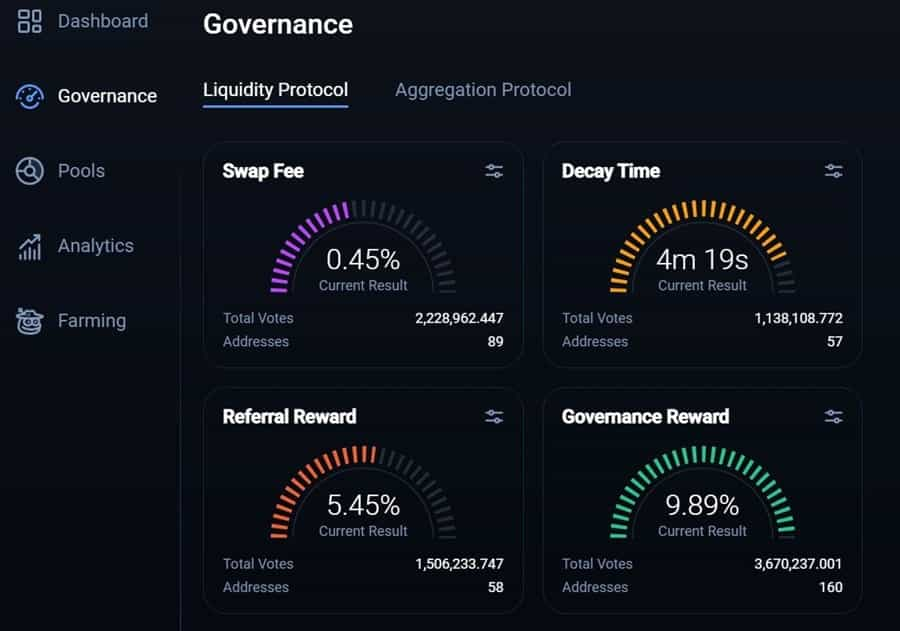
One of the greatest benefits of using the 1inch Exchange is how it can lower the gas fees paid for transactions. With current transaction fees ranging from $30 - $60 or more on a good day, it is increasingly important to minimize gas fees. 1inch does this in two ways: through “Infinite Unlock” and its CHI Gas Tokens. We will discuss both in more detail later in the review.
The 1inch Token
The 1INCH token is much more than an ERC-20 utility token for the 1inch Exchange. It is an instant governance token used to provide governance to the DEX aggregator and liquidity protocol.
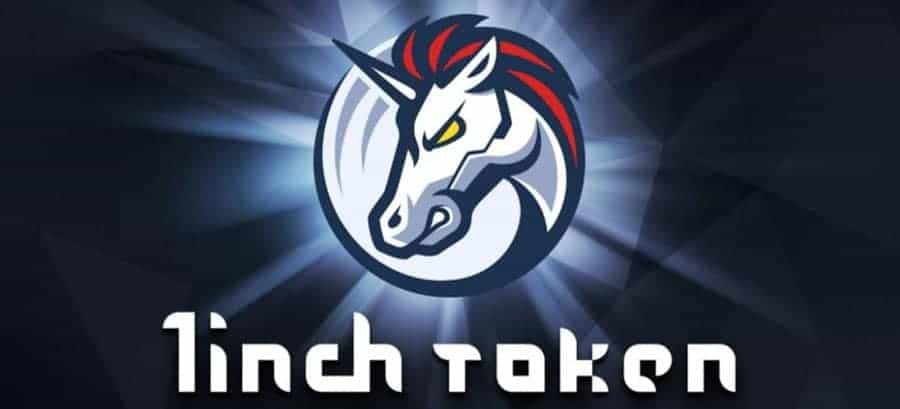
Holders of the 1INCH token, no matter the amount, can use their voting power to decide on various parameters of the 1inch protocol. These include the governance reward, the swap fee for the liquidity protocol, the price impact fee, and the decay time for the exchange. These parameters are found under the DAO tab of the 1inch Exchange website. Users can also go here to vote on current proposals.
The total supply of 1INCH tokens has been set to 1.5 billion, with 30% of that allocated to the 1inch community. The 1inch team has chosen to distribute these community tokens via airdrops, and the total supply is planned to be distributed over 4 years.
The remaining token supply will be used for development (14.5%), of which 8% of that was given to investors during its latest funding round. The rest will gradually be distributed to the early investors and team members (55.5%).
The token is issued by the 1inch Foundation, a non-profit organisation established to foster the 1inch Network and its burgeoning community. Some of its activities include:
- Engage early adopters
- Encourage users to stake 1inch in governance proposals
- Issue development grants for projects benefiting the 1inch protocol, which also includes yield-farming initiatives.
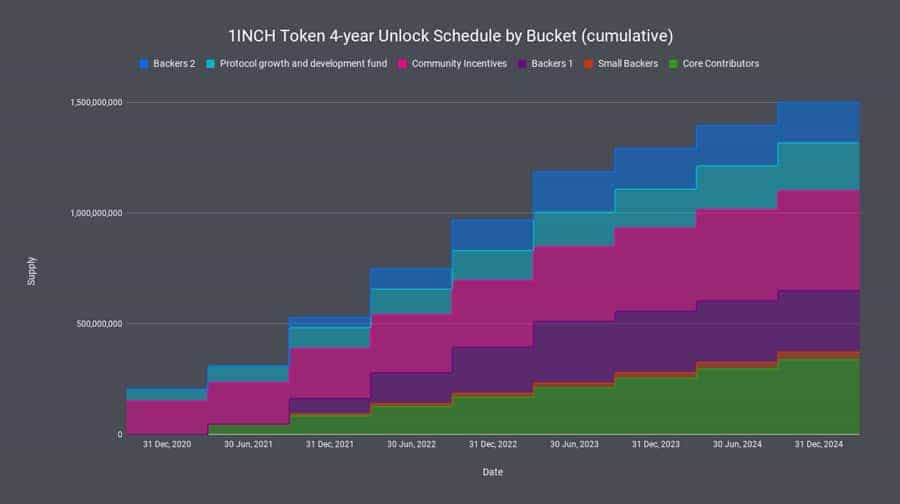
1inch Tokenomics
The 1inch token currently has a circulating supply of 413,777,581 out of 1.5 billion tokens. Its market cap sits at $648,493,023 with a TVL of $20,183,869. The token itself is mainly aimed at the "hold and earn" zone, so its trading potential is somewhat decent. Hitting an all-time high of $8.65 back in October 2021, its current price of $1.57 looks quite a bargain.
While it looks to be a gradual downward dip since the high in October, with the range of innovations coming from the team, all it takes is another notable partnership or two to drive its price up. Although it may not be the most volatile token to substantial net gains for short-term traders, medium to long-term holders might be pleasantly surprised in the future.
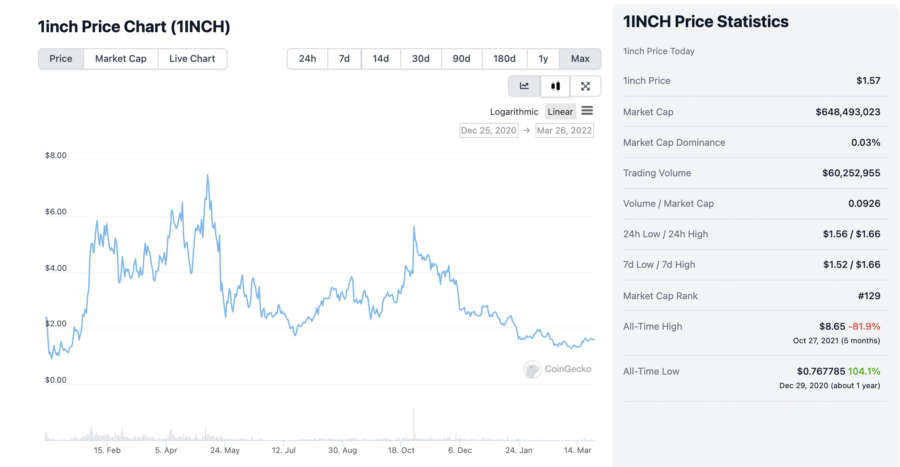
1inch DAO
Unlike other protocols with DAOs, there is no minimum requirement for holdings at 1inch. Users with any 1INCH tokens are free to vote and have a say in the potential changes to the protocol parameters and governance proposals. They do so by staking their 1inch tokens, basically putting their money where their mouth is.
There are two phases to the DAO's implementation. The first phase kicked off in December 2020. In this phase, the 1inch tokens were distributed to community members according to a lockup release schedule. The core community members play an essential role in ensuring the governance is done efficiently as the process stabilizes and matures.
In the second phase, currently underway, the team moves towards enabling complete governance control and the treasury to the DAO. Two types of voting tokens emerged with different voting powers.
- st1INCH tokens, synthetic non-transferable versions of the staked 1inch tokens in proposals, have full voting power.
- v1INCH tokens, representing the 1inch tokens locked in vesting contracts, have 1/5th the voting power of st1inch.
Buying 1inch Tokens
In the early days of the protocol's launch, the only way to get your hands on the 1inch token was to have some crypto on hand to swap them within DEXs or at the 1inch Exchange. It feels a bit like doing a transaction in a shady alley. The only major CEX to get it then is Binance. Since then, it's gotten listed in major CEXs such as Coinbase and Kraken, to name a few. This gives the token a lot more cache as a legit token for those who know little about it. More importantly, entrance to these exchanges allows for purchasing the tokens with fiat, not just crypto. That widens the token's access to the masses, which is a desirable situation for the 1inch team.
1inch Airdrops
One of the things that created the initial excitement and buzz around the 1inch Exchange was its choice to airdrop tokens as part of the token launch.
As part of that airdrop, all wallets that interacted with 1inch until December 24, 2020, at midnight (UTC), received 1INCH tokens as long as they met one of the following conditions:
- at least one trade before September 15, 2020;
- at least 4 trades in total;
- trades for a total of at least $20.
As a result, 90 million tokens were airdropped on Christmas Day 2020. A short while later, on February 12, 2021, the second airdrop of 6 million tokens was made to Uniswap users. The marketing ploy delivered tokens to Uniswap users who met the following criteria:
- Traded at least 20 days on Uniswap;
- Placed at least 3 trades in 2021;
- No bots allowed.
 Early adopters of 1inch were quite pleased by the surprise airdrop. Image via 1inch blog.
Early adopters of 1inch were quite pleased by the surprise airdrop. Image via 1inch blog.
There was also a second airdrop of 9 million 1INCH tokens to members of the 1inch community who were overlooked during the first airdrop. The distribution scheme applied to Mooniswap (revamped to 1inch Liquidity Protocol in December 2020), some wallets with transaction relayers and limit order users, and some liquidity providers to 1inch pools who did not receive it tokens they were entitled to in the initial Christmas distribution.
Will there be more airdrops? Who knows for sure. There have been ongoing liquidity mining programs that distribute additional tokens based on providing liquidity to specific pools, and we expect that will continue for some time. To find out about new airdrops and liquidity mining programs, keep an eye on the 1inch Exchange blog or other social channels.
1inch on the Binance Smart Chain
On February 25, 2021, the 1inch Foundation deployed the 1INCH token on the Binance Smart Chain, making the 1inch Aggregation Protocol and the 1inch Liquidity Protocol available to BSC users.
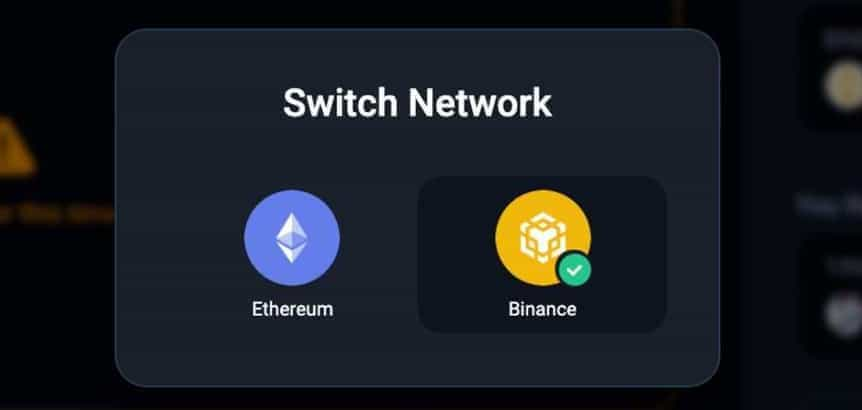 Adding a bridge to the Binance Smart Chain was a smart move. Image via 1inch blog.
Adding a bridge to the Binance Smart Chain was a smart move. Image via 1inch blog.
The 1INCH token on Binance Smart Chain will be used for a bridge between the Binance and Ethereum networks. When a user sends 1INCH tokens to the BSC, they will be locked in Binance Bridge, and a corresponding value in 1INCH tokens on Binance will be consequently unlocked. Thus 1inch users will get access to PancakeSwap and other BSC based decentralized exchanges and lending protocols.
There have been 10 million 1INCH tokens initially issued on BSC, and they will be used as liquidity in Binance Bridge for transactions between Ethereum and the Binance Smart Chain.
Other Bridges on 1inch
1inch has also introduced bridges to different networks, allowing users to freely move their tokens to other networks at a low fee. The bridges currently supported are Gnosis, Polygon, Arbitrum, Optimism and Avalanche, in addition to the BNB bridge mentioned above.
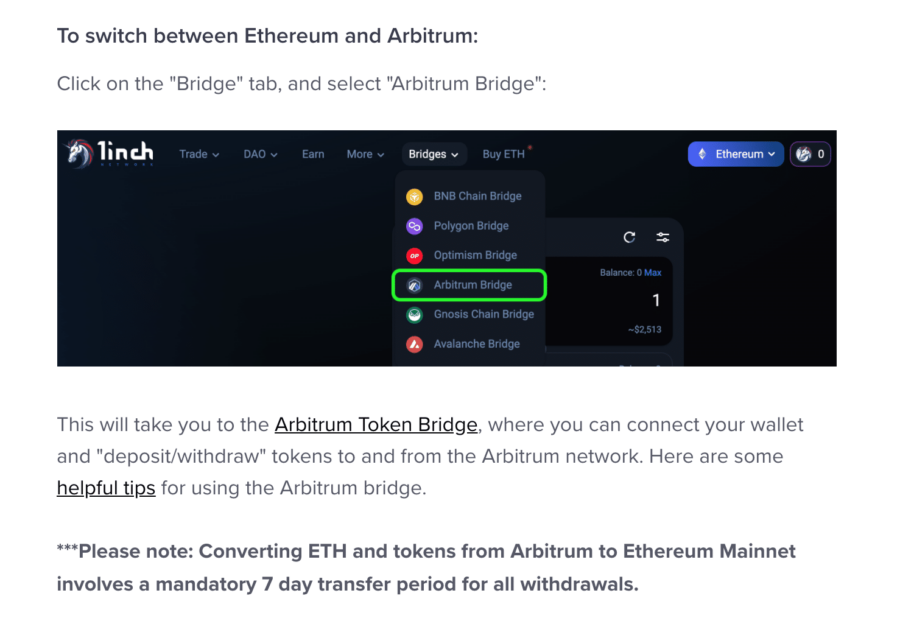
After selecting a bridge, you will be brought to the respective network and be asked to connect your Web3 wallet to the site. Once there, select which tokens you would like to bridge over, then hit the "Transfer" button.
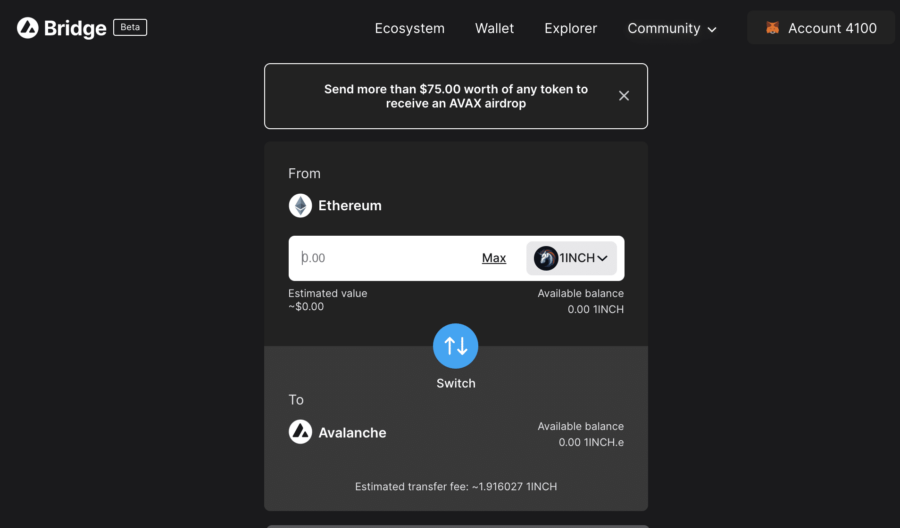
Staking the 1INCH Token
While the most essential function of the 1INCH token is its governance feature, it also has a staking feature that lets any 1INCH holder stake the coins and make more 1INCH tokens. Tokens can easily be staked by going to the DAO tab on the website and then navigating to the Governance section.
Those who choose to stake their 1INCH tokens receive rewards from the swap fee and the price impact fee. Plus, those who hold the 1INCH token have the right to vote on both these parameters, and when voting, holders also receive governance rewards.
Staking 1INCH tokens is quite simple. First, you need to acquire some 1INCH tokens if you don’t already have some. Then navigate to the 1inch Exchange and click on the DAO tab. Once on the DAO page, go to the Governance tab if not already there. Next, find the token staking box in the upper right section of the page and click on the button to Connect Wallet.
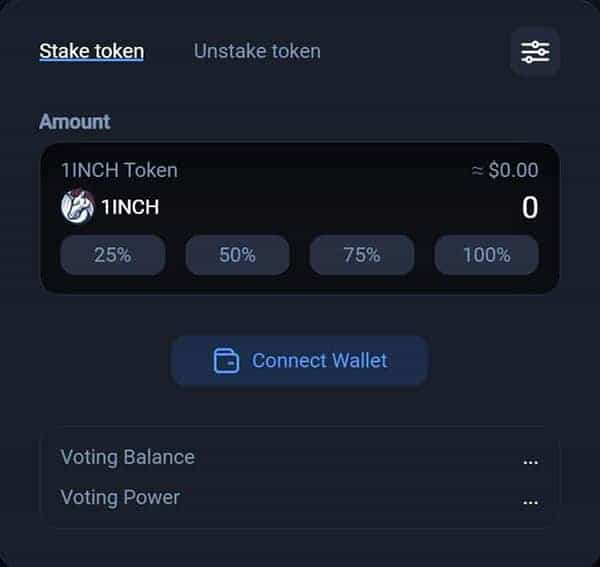 Staking is easy at 1inch Exchange. Image via 1inch.exchange
Staking is easy at 1inch Exchange. Image via 1inch.exchange
Once the wallet is connected, you enter the amount of 1INCH tokens you’d like to stake and then unlock them. You can use the regular “Unlock” or choose to use the “Infinity Unlock” feature. The Infinity Unlock will save you from paying gas for this transaction again, but it could present a security risk if it is ever exploited.
You can also click the settings icon in the upper right corner of the staking box to change the gas cost between Standard, Fast, and Instant. Of course, once staking is unlocked, you can always stake more by making a last transaction.
CHI GasToken
The CHI gastoken was introduced as a way for 1inch Exchange users to save on Ethereum gas fees, which can become quite expensive. Think of gas like the fees charged by banks on transfers; however, with gas fees, the more traffic there is on the network, the higher the gas fees. Due to the popularity of DeFi apps, the Ethereum network has become quite congested, and as of March 2022, gas fees on 1inch are in excess of $35 per transaction.
The CHI gastoken is an ERC-20 token used to pay transaction costs on the 1inch Exchange. According to 1inch, the transactions on the exchange are up to 42% cheaper because of the CHI gastoken.

The price of CHI is pegged to that of Ethereum's gas price, so when the gas price is high, the cost of CHI will also be high, and vice versa. CHI is similar to Ethereum's gastoken (GST2) but with some improvements. For example, buying (minting) CHI saves you 1% compared to minting GasToken. Whereas CHI's selling (burning) saves you 10%, compared with GST2.
1inch Supported Wallets
Because 1inch is a decentralized exchange aggregator and liquidity provider, there is no requirement to create an account to trade through them. All that's needed is to connect a supported wallet to the exchange and fund it with supported ERC-20 tokens. There are never any third parties between your wallet and the exchange.
The 1inch Exchange does support several wallets for swapping tokens. The wallets supported include MetaMask, TrustWallet, MEW, WalletConnect, and the Ledger hardware wallet.
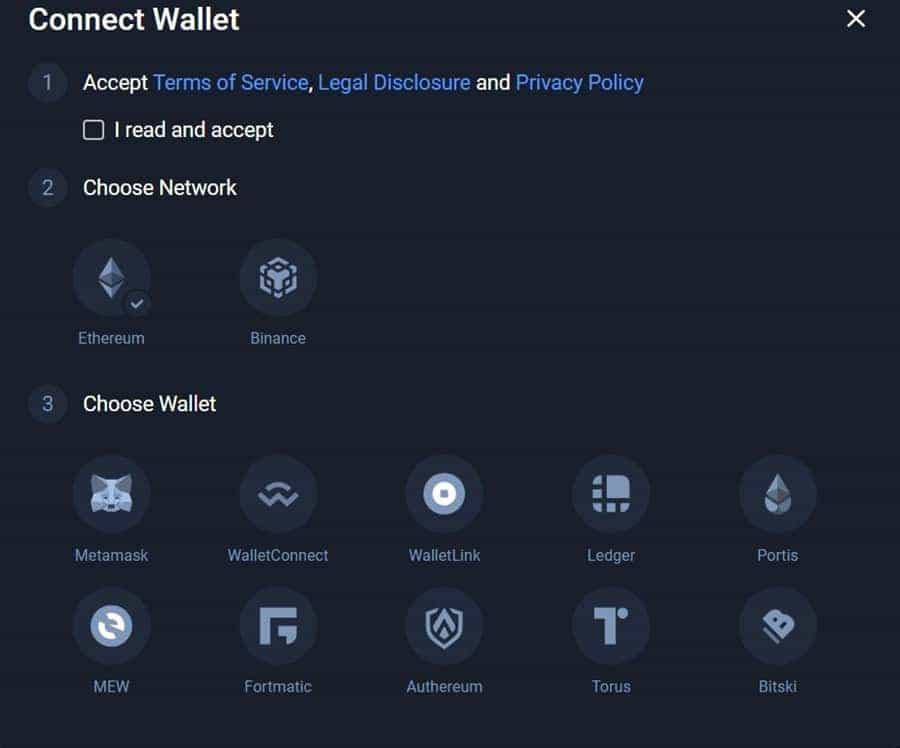
The 1inch Exchange can be used with several web-based, mobile, and hardware wallets, depending on your preference. Below we show you how to use the 1inch Exchange with the MetaMask wallet.
How to Swap on 1inch Exchange
Below are the three steps to completing a swap on the 1inch Exchange:
Step 1: Connect your ETH Wallet
You will have the option to connect your wallet right from the homepage. Find the “Connect Wallet” button in the upper right corner of the website and click it. You’ll need to accept the terms and conditions, choose between the Ethereum or Binance Smart Chain networks, and choose the wallet you’re trying to connect.
Step 2: Select the Token
Once your wallet is linked, you can choose which tokens you’d like to exchange. In addition, the 1inch Exchange will display a comparison chart showing the exchange rates from various linked DEXs.
Not only is it possible to see the individual rates, but you can also compare those with the best rate available.
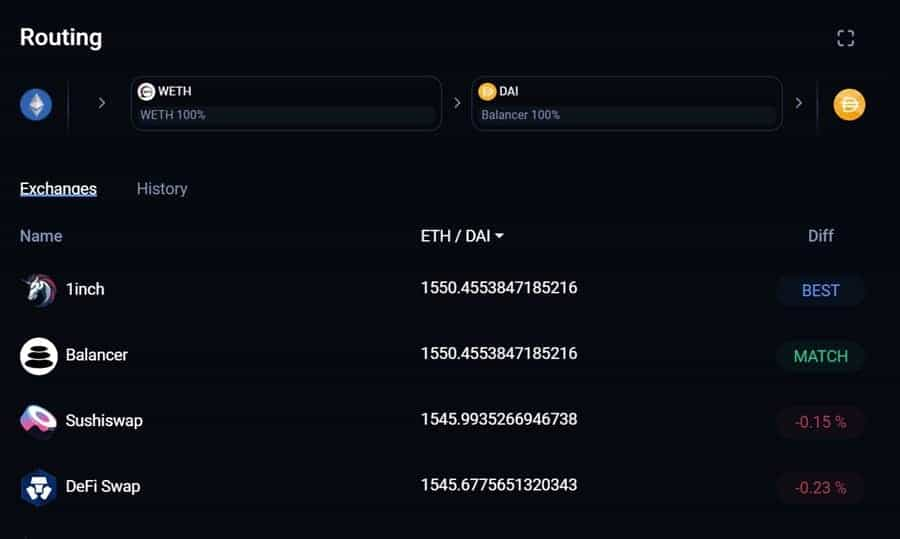
In some cases, you might not be able to find the asset you’d like to swap in the menu. This can occur if the asset hasn’t been whitelisted yet by 1inch. In this case, you can apply for the token to be whitelisted, or you can simply add it as a custom token by clicking the small circled plus icon in the upper right corner of the order entry box.
Step 3: Swap Tokens
The token swap has several parameters you can choose from. It will allow for a market order or a limit order, and you can choose to execute the order for the maximum return or for the lowest gas price. In either case, it will show you your exchange rate, the USD value, and the anticipated fees for the exchange.
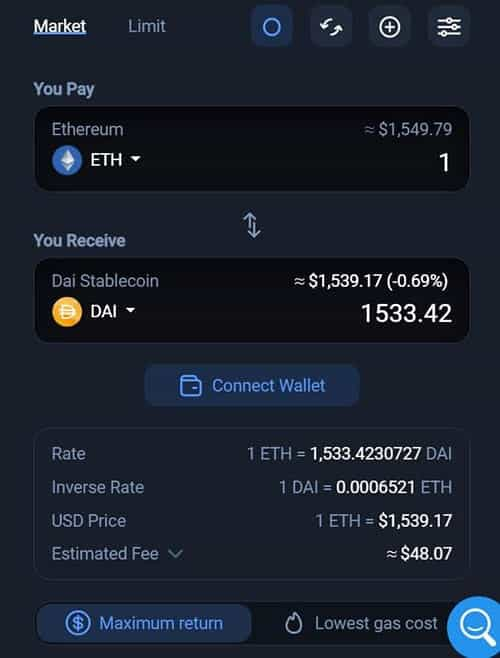 Choose from limit or market orders, best exchange or lowest gas, and swap your tokens transparently. Image via 1inch.exchange
Choose from limit or market orders, best exchange or lowest gas, and swap your tokens transparently. Image via 1inch.exchange
You’ll next need to unlock the token, and you can either unlock just for this exchange or choose the Infinity Unlock option. The former is more expensive in the long run, but it is also potentially more secure.
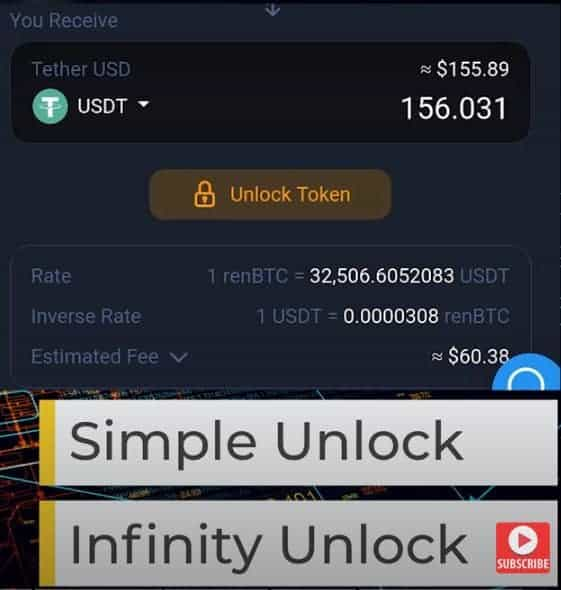
Once the tokens are unlocked, you can confirm the swap by clicking the “Swap Now” button. Next, you’ll be presented with all the swap details and asked to verify them once again. And then finally, you’ll need to approve the transaction in your wallet, and it will be sent to the blockchain.
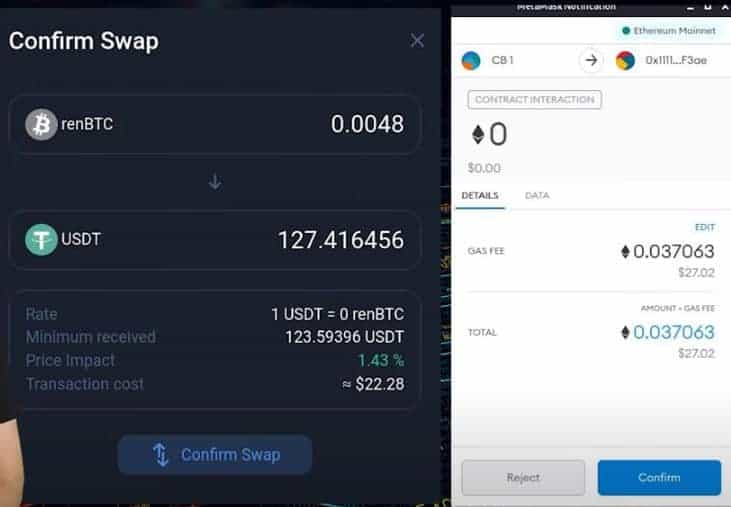
1inch Wallet
Any DeX looking to be a serious contender needs to have its own wallet, all the easier to ringfence users into its ecosystem and keep them happily in the pen. That's what the 1inch Wallet aims to do. Being a native wallet of the DeX, in addition to the standard functionality you'd come to expect from any wallet worth a second glance, it is also tightly integrated into the DeX in the following ways, to name a few examples:
- set gas fees in both basic and advanced mode
- stake tokens through the wallet
- claim various rewards offered by 1inch such as airdrops etc
- change wallet cover/skin
- enable/disable biometrics when used with iOS phones
- buy crypto with fiat through the wallet
- support for NFTs
The wallet app is currently available only on iOS at the moment. An android version is listed as Coming Soon on the website.
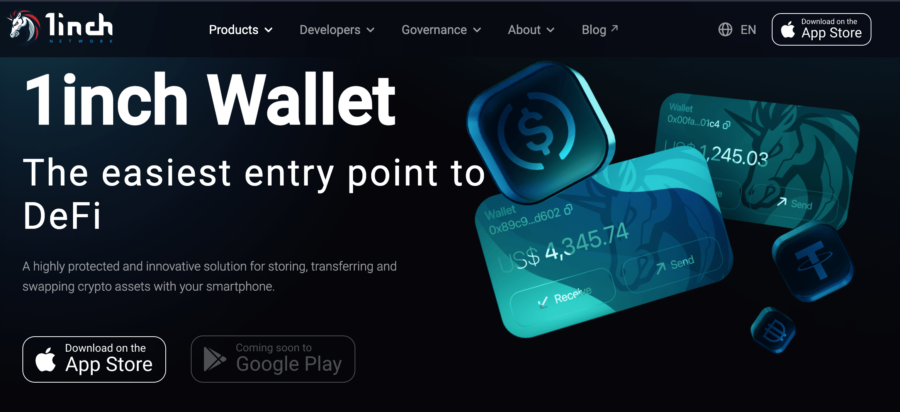
The wallet is also integrated with Apple Watch and other non-DeFi sites like Coingecko, CoinMarketCap and Dune Analytics, in addition to blockchain networks such as Polygon, Ethereum and the Brave Browser.
DeFi Racer Game
The most innovative aspect of the 1inch wallet is the DeFi Racer Game, a car-racing game found inside the wallet. The main purpose of the game is to go as far as possible without hitting obstacles while collecting in-game coins. These coins will allow the user to unlock in-game features and assets such as new cars.
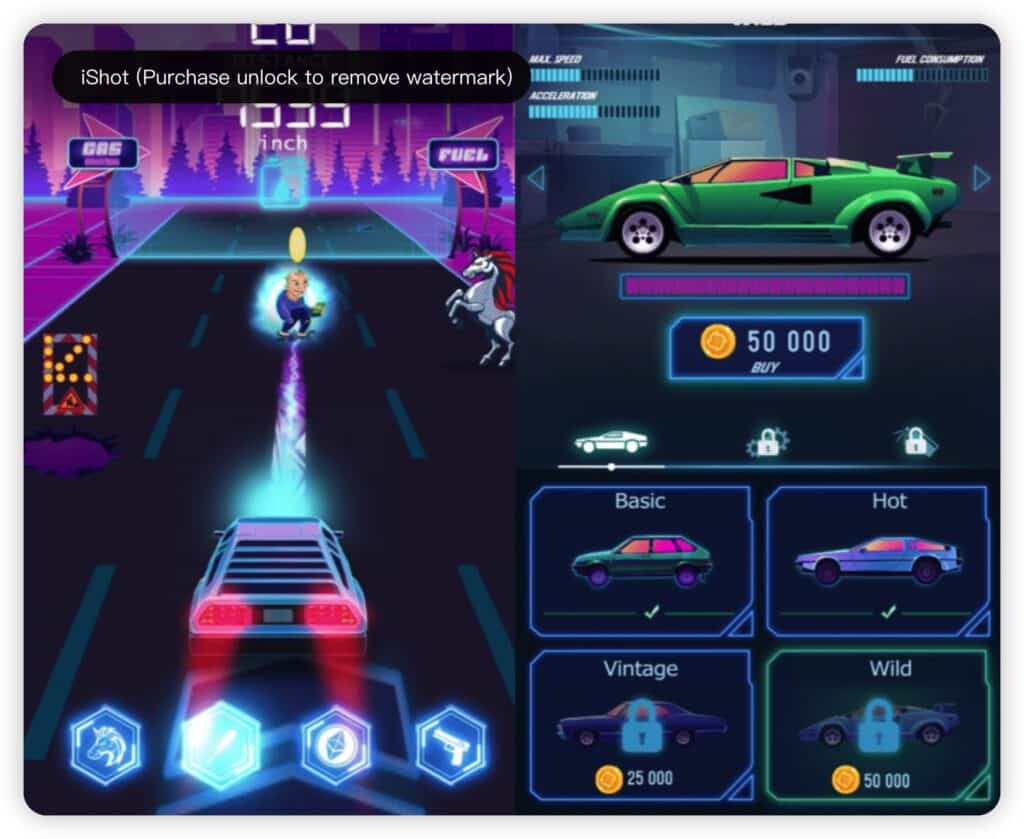
Users are encouraged to participate in online tournaments to vie for the grand prize: 1,500 1inch tokens. Whoopee! Tournament start days and times are posted on 1inch's social media channels together with the rules.
The game was released in December 2021 and built by Nord Beaver studio from a development grant by the 1inch development fund. This is the first foray for 1inch into GameFi and Web3.0. There is also mention of NFTs coming soon.
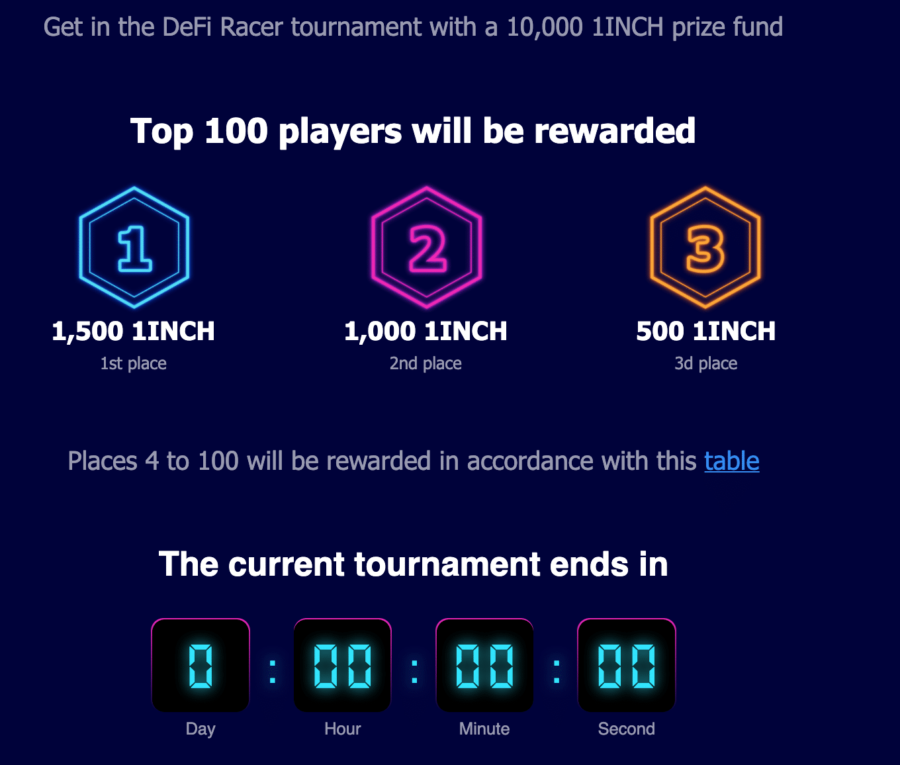
This is quite a brilliant idea because it uses the wallet app as a game app as play is not restricted to using the DEX. A brand-new wallet with zero transaction history can still play it. It's a great way to hook in players or even non-crypto noobs. I'm looking forward to how they will continue exploring ways to get more entrants into the 1inch world.
Depending on the game's popularity, we might see more of such features in the 1inch wallet in the near future. I can totally see other wallet developers jumping on the bandwagon for this one, and it won't be long when we have all kinds of racing or some such games appearing in wallets.
1inch Infinity Unlock
I've mentioned the Infinity Unlock feature several times, so now might be a good time to look at it in more detail. Basically, it gives the platform permission to spend a specific token forever, meaning you won't have to spend gas to unlock the token again in the future. While it is a saving on transaction fees, it could potentially be dangerous if a hacker finds a way to exploit it in the future. The basic Unlock feature is more expensive in the long-run but also more secure.
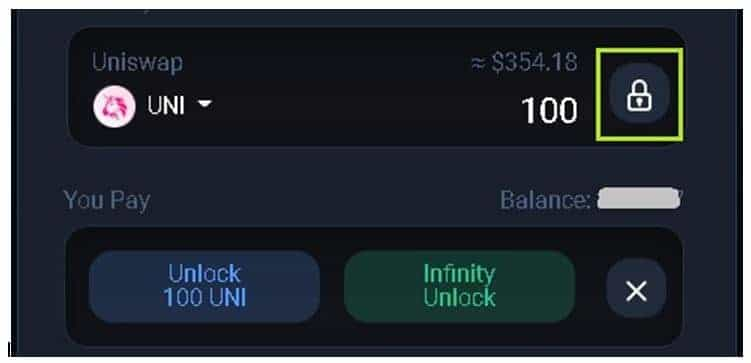
1inch Liquidity Pools
The original liquidity pools for 1inch were on the Mooniswap portal, which was based on the Uniswap model. More recently, the Mooniswap portal has been deprecated and rebranded 1inch Liquidity Protocol and moved to 1inch Exchange.
You can find the 1inch Liquidity Protocol pools by navigating to the DAO tab on the exchange website and then going to the Pools tab in the left sidebar. Those who may have had liquidity remaining on Mooniswap could remove that liquidity and move it to the 1inch Liquidity Protocol.
As you can see, there are a number of pools available with good liquidity and very generous APYs.
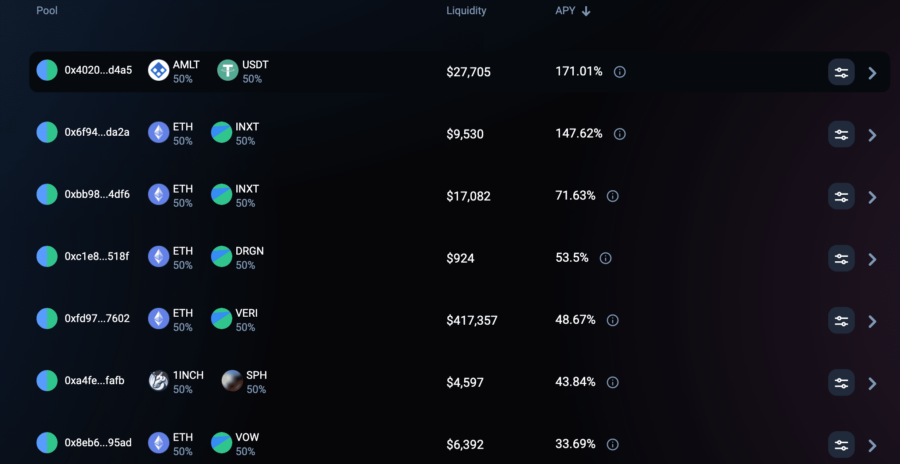
Not all pools are included in the 1inch farming, so if you are interested in staking your LP tokens to earn 1INCH tokens, you should choose liquidity pools such as 1INCH-ETH, 1INCH-USDC and 1INCH-DAI.
Adding Liquidity to Pools
You know all about adding liquidity if you’ve worked with any AMMs before, and the 1inch pools aren’t different. You start by connecting your wallet if it isn’t already connected. After that, you’ll navigate to the Pools section of the portal under the DAO tab. There you’ll see all of the available liquidity pools, including how much liquidity is in them and the APY they are currently yielding.
Find the pool you’re interested in providing liquidity to and click on it. Then find the “Provide Liquidity” button and click it.
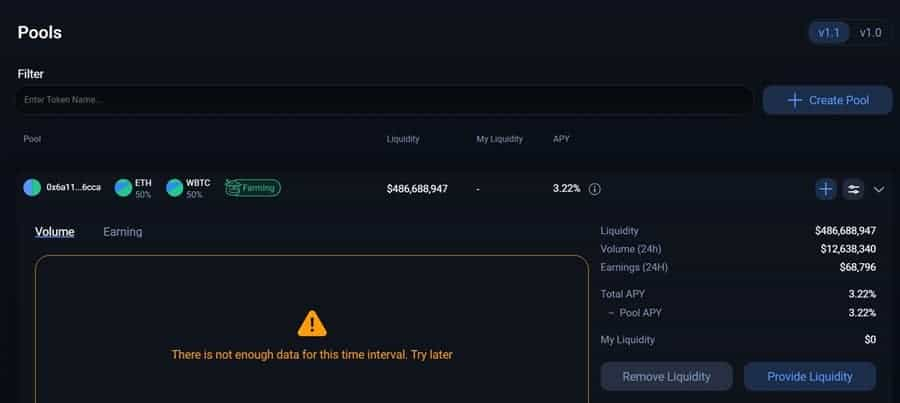
When you're providing liquidity, you need to deposit an equal value of each token into the pool. 1inch makes this easy enough, and you can simply add the amount for the LP token you want to mint and then adjust it based on the amount of crypto you want to add to the pool.
You'll again use either "Unlock" or "Infinite Unlock" to allow the platform to use your coins. After unlocking the pair of tokens, you can add liquidity in the future by making a final transaction.
Virtual Rates
A feature of 1inch when it comes to liquidity is Virtual Rates. It is designed to protect against 'front-running" attacks. The term itself comes from the old days in stock exchanges where the ones posting the trades on behalf of others will put their own trades to benefit from the knowledge gained. In this case, the rate shown is a "fake" rate matching the previous swap, or it remains the same for future swaps in the same direction instead of the real rate. Therefore, any bots seeing the rates would not be able to react accordingly. After a successful swap, there is a "decay period" for the fake rate. This can be anywhere between 1 - 5 mins. The period of time is voted on by the DAO community.
Staking 1inch LP Tokens
Once you've provided liquidity to one of the pairs included in the liquidity farming portal, you will be able to stake those LP tokens and earn 1INCH tokens.
Get started by clicking the Farming link in the left sidebar of the DAO page. Now you'll see all the 1INCH farming pools that are available, and you'll be able to stake your LP tokens.
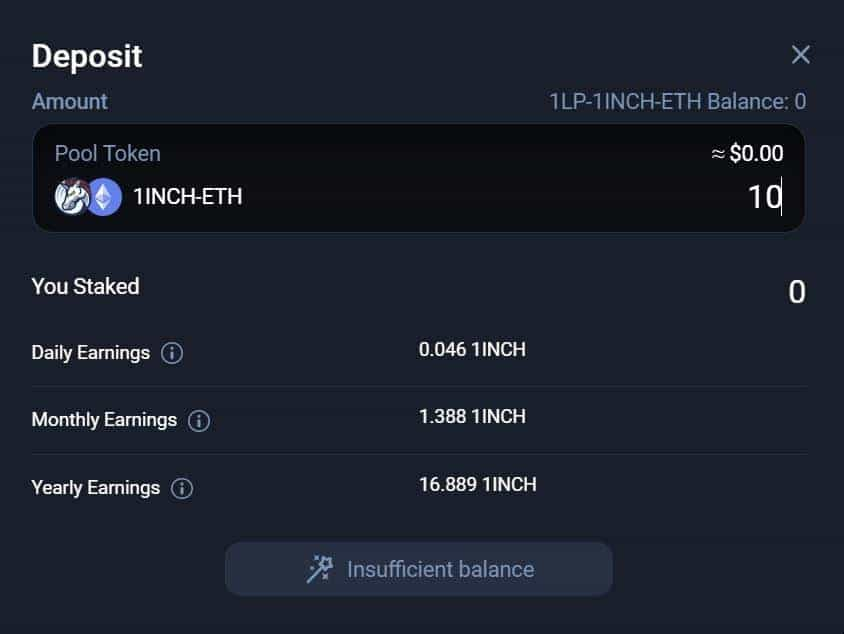
When you click the Deposit button for any of the pools, it will bring up a form to input how much you want to stake in that pool. Once you enter an amount, it will estimate your daily, monthly, and yearly 1INCH earnings.
1inch Exchange Security
As is the case for anything crypto-related, security is key and a primary concern for all users.
One way 1inch is secure is that it is a non-custodial DEX aggregator platform. That means they never have possession of your coins or the private keys. So, unlike centralized exchanges that require you to deposit your cryptocurrencies to trade, at 1inch, your coins always remain in your wallet and in your possession.
One further nod towards the security at 1inch is that the platform has never suffered from any hacks or security threats. And since you never provide them with any personal information, not even an email address, there's no need to worry about data breaches.
1inch Customer Support
While you might not expect much in the way of support from a decentralized exchange with no account registration process and no fees for trading, the 1inch team has actually made sure that customer support is available through several channels.
- Email support – [email protected]
- 1inch Exchange Help Center
- Live Chat
- 1inch Exchange support group
- Telegram group
Furthermore, the 1inch team is also active on social media channels such as Twitter and YouTube.
1inch and Skynet
Of all the partnerships that 1inch has aligned itself with, the one with SkyNet looks to be the most intriguing. Here's a quick primer on what is Skynet:
Skynet is an infrastructure project that supports a decentralized version of the Internet by hosting it. Developers use the toolkit provided to build open-sourced applications that carry censorship-resistant content for users with a universal log-in identity and the ability to own their data.
Now that we have an idea of what Skynet is let's look at how the integration with 1inch fits in.
When interacting with the 1inch dApp through a browser, the user may be susceptible to being hacked. This is because there's no way to know if the programming code has been tampered with by the browser. There is also no concept of an older version of a webpage that one can go back to, like a time machine for web pages. With the Skynet integration, 1inch users who are also Skynet members can upload the saved version of the web app to their Skynet storage, a decentralized storage area. These versions can be accessed even if the website itself goes offline or is compromised. All this is done via the SkyNet Homescreen page accessible to all SkyNet users.
The key takeaway for this collaboration is about safeguarding the user's security in ways that the user might not even be aware of. It may be a bit difficult to wrap one's head around this. However, it could be the beginning of something that we could see more of in the coming days, especially if there is a popular dApp involved.
Conclusion
Overall it seems clear that the innovative features and tools provided by the 1inch Exchange can far outweigh any potential issues with the platform. In fact, we think the 1inch Exchange has done an excellent job in handling some of the problems that plague the emerging DeFi ecosystem.
One of their solutions is the provision of far greater liquidity than many of the existing DEXs. The lack of liquidity is a problem caused by the fragmentation of DEX platforms, but as an aggregator, 1inch more than makes up for this.
By splitting orders across multiple exchanges where necessary 1inch does away with the slippage that can lead to far higher than necessary trading costs. It's also quite nice to compare the rates and gas fees being offered across multiple exchanges. Active traders will find that this can save them quite a bit of time wasted in looking across the order books of multiple exchanges.
Features such as CHI gastoken, the 1inch Liquidity Protocol, and the addition of limit orders bulks up the useability of the dApp for all sorts of users. Furthermore, by including bridges to other networks, 1inch is keen for itself to be integrated with as many partners as possible, thus extending its relevancy in the crypto world.
Coupled with novel ideas like the DeFi Racer and SkyNet to lure more users to the 1inch universe, we can expect more innovative initiatives from the 1inch team in the coming years. One idea could be enabling cross-chain swaps, proposed by Messari in their report on the project. This involves the combination of multi-chains and L2s with the Pathfinder algorithm. It could even lead to cross-chain staking, where users buy a token from one chain through 1inch and stake them for rewards in another. Maybe 1inch can charge a small commission for each successful first-time stake done through its network, like collecting toll fares on the open highway.
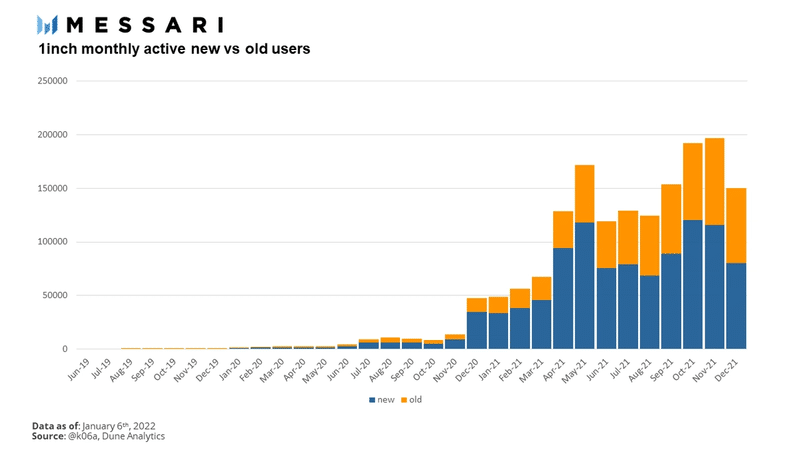
The team has put in a lot of effort to attract new users, both crypto beginners and non-crypto beginners. While there is still a bit of an entry barrier for the latter group, the website design has aimed to simplify the UI as much as possible for performing various tasks.
By putting the DeX into the 1inch wallet and a snazzy game in it, the team knows that the best way to grow is to make the pie bigger for everyone.
Frequently Asked Questions
The arm of the US regulatory agencies are long, and the shadows cast by them are even longer. Centralized exchanges that do KYC for customers usually have an international and US version of their platforms to stay on the good side of Uncle Sam. In some cases, instead of having two versions, they might limit access to certain tokens for US citizens as a preventive measure from dealing with the SEC.
You'd think that decentralized projects like 1inch won't care about things like this. However, since September 29, 2021, US citizens have been geo-fenced from using 1inch as it currently stands. US citizens will have to wait to use the regulated version of 1inch, known as 1inch Pro. The key audience for this is institutional investors because that's where the big money is. It's all well and good to have retail support, but deep liquidity is still a must for any kind of exchange to be truly successful. Big money won't come in unless there is some regulatory framework they can hang their coattails onto, so that's the situation. No word yet on when 1inch Pro will be available. In the meantime, too bad US customers.
At first glance, I'd almost say it's a non-comparison. One is an aggregator that scrapes tons of Dexes for the best price. The other is a single DeX. Apples and oranges, right? Well, not quite. Things aren't as straightforward because it all depends on what you're trying to achieve. It may sound like a cop-out but hear me out. Let's try looking at it from the following angles:
Amount of tokens swapped
The key advantage of 1inch is that it scours Dexes for the best price. Where necessary, a single swap might have a few DeXes behind it because it's about securing the best price. If you have a sizeable amount to swap, you will likely pay fewer fees than if you use a single DEX like Uniswap. If you use the Chi token, you might be able to save even more.
For very small amounts that may not require the participation of more than one DEX, you could reap the benefits of 1inch's scouring by checking out which DEX holds the cheapest and going to that DEX directly.
Liquidity and trading
When it comes to making trades and liquidity, TVL is an important metric to consider. Uniswap is the OG of DEXs. Many people got started in DeFi from using it, and like most things, it's habit-forming. Unless there is a serious issue with it, most people are happy to stick with what they know. However, those new to DeFi and looking to dip their toes in would do well to make some basic comparisons between both platforms. The main question is: which liquidity pool can help me make the most money?
Speaking of making money, well, how does that work for 1inch? Although no fees are being charged by the exchange, it can still generate revenue. For example, it receives a portion of the swap fees that go to the liquidity sources it is partnered with. It can also make some revenue from positive slippage of orders. These earnings go into pools to pay referrers and for the payment of the governance rewards.
It is a very fair question to ask, and here is an honest answer. The short answer is: as safe as a DEX can be. I say this because they've been audited to the gills by various known entities such as Coinfabrik, ConsenSys, Certik etc. This provides a certain level of security against smart contract risks. As for the possibility of rug pull or other such shenanigans related to founders, raising $175 million from venture capital firms kinda puts that to rest.
The closest one that comes to mind is Matcha. Just like 1inch, it is also a DEX aggregator that hunts for the best prices for trades. It's also built on the Ethereum network and works with Uniswap, Kyber Network, Balancer and Curve. They also feature gasless trading (without slippage) and limit orders. However, it's not listed in either DeFiPulse or Defi Llama.
Another one is OpenOcean. Proclaiming itself as the competitor for 1inch, OpenOcean is also an aggregator for CEX and DEX. The CEX, in this case, is Binance. They utilise the D-star algorithm (as opposed to Pathfinder) to search for the best prices and work with DEXs on networks like Solana, Polygon, Fantom and Avalanche, to name a few.
They also practise "slippage subsidies" whereby the higher exchange value gets refunded to the user while the lower value gets mitigated by subsidies from the protocol. They also have their own OOE governance token for VIP members. The TVL currently stands at $3.32 million, according to DeFi Llama.
Competition in this space involves getting data from the same DEXs and dApps across a number of chains. Since the rates are the same, it's more about how they can distinguish themselves from their competitors and also offer the lowest fees and most liquidity. How quickly they can innovate, execute and expand will be the keys to success.
Disclaimer: These are the writer’s opinions and should not be considered investment advice. Readers should do their own research.

